Have you ever looked closely at the twist on your embroidery floss?
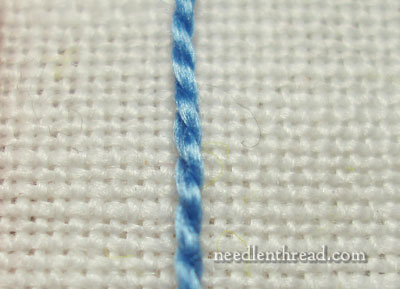
This is a close-up of a #5 perle cotton embroidery thread, by DMC. Look closely at the twist! Besides being just downright pretty, the way the plies wrap around to form the strand, there’s actually something significant here. This is an S-Twisted embroidery thread.
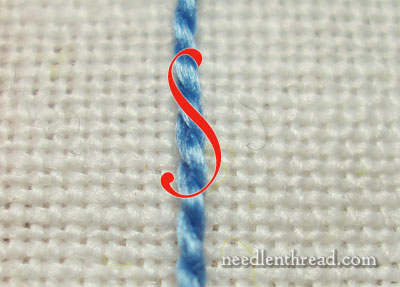
It’s called s-twisted, because the direction of the twist follows the central slant of the letter S.
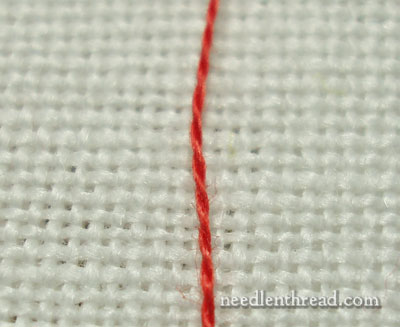
This is a single strand of DMC cotton embroidery floss. It’s a lot finer than the #5 perle cotton above, and the twists are not quite as compact and pudgy, but, if you look closely, you can see that both threads twist in the same direction.
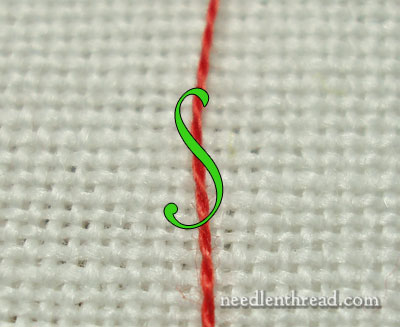
Both of these cotton embroidery threads – the perle cotton and the regular stranded cotton floss – are s-twisted threads.
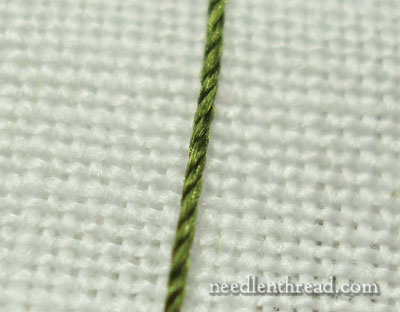
Here, we have a strand of Soie Perlee, which is a silk embroidery thread made by Au Ver a Soie. Do you notice the difference in the twist?
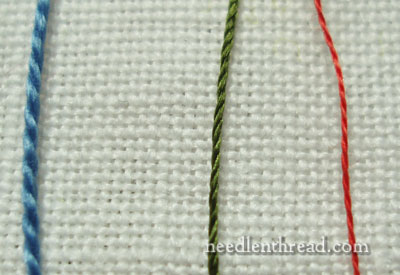
If you look at all three threads lined up together in one photo, you can see a definite difference in size, with the #5 perle cotton being the thickest, then the Soie Perlee next in line, and finally, the single strand of cotton being the finest of the three here.
But you can also notice something else, if you look at the three and compare them.
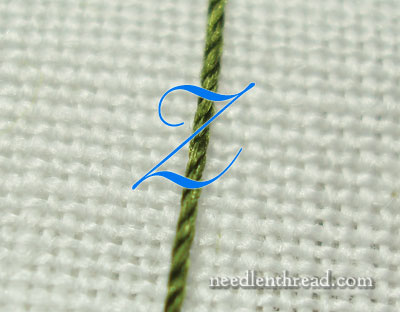
The Soie Perlee is a Z-Twisted Embroidery Thread. It’s called that, because the twist lines up the slant on the letter Z.
Now, all of this technical stuff is well and fine, but what does it all really mean for you, the stitcher?
Well, not necessarily a Whole Lot, but it depends! In most commonly used embroidery stitches, you’re not going to see that much of a difference between the way the stitch looks, whether you’re using an s-twisted thread or a z-twisted thread. But there are some exceptions. You see, as you stitch, depending on the stitch you’re stitching and the way the stitch twists the thread (whether with the twist or against it), some stitches will look quite different if you’re using a z-twisted thread compared to an s-twisted thread.
Stitches not affected by the twist of the thread would include straight stitches that pass through the fabric without working with the stitch before, like backstitch or running stitch, or satin stitch. Stitches like chain stitch are not affected, either.
Stitches that are affected by the twist of the thread include stitches that twist together, such as stem stitch or outline stitch, as well as stitches that involve wrapping the thread, such as the bullion knot, and even (to a minute degree) the French knot (though the French knot is so small that you don’t really notice the twisty-thread-thing going on with it).
Next up, we’ll look at some stitching differences between s-twisted and z-twisted threads, just to prove the point that there is a difference between the two twists when stitching certain stitches, and that the difference will affect the way your finished embroidery looks. And later on, we’ll look at a list of common threads that fall into each category.
Any questions? Feel free to leave a comment and ask!







Very interesting topic, I had been making bobbin lace for a while before I read about S and Z twisted threads. One of them is better for bobbin lacemaking (can’t remember which), the other type sometimes unravels a bit as you take thread from the bobbins.
Hadn’t thought of the effect on embroidery, so I enjoyed this topic
regards
Julie in Australia
Thanx for such an informitive site. I have been following you and although I could not do much in 2010 because of very advanced cancer, your site inspired me. I’ve read about s- and z-twisted threads and although you showed so clearly, I fail to see the z-twist. What’s wrong with me ?! Looking forward to tommorrow’s pics, maybe I’ll see it better when it’s worked. Keep well.
It is a very important point for lacemaking threads! Usually linen threads are S spun and are OK, metallic threads are Z spun and may not used if the pattern includes much Twist stitches.
This is a very good lesson, Mary. I’m looking forward to learning more about it tomorrow. Thank you.
Explains why my French Knots come out so terribly!
Thanks!
Thank you so much for explaining the difference. I had wondered before, in passing, why they were called s- and z- twisted. Once an expert explains, it becomes blindingly obvious! 🙂
I look forward to tomorrow’s post.
Actually thread twist can have an effect on running, back and double running stitch.
I do a lot of double running. As a right handed stitcher, I find that my needle rotates a bit with each stitch made. This introduces twist in one direction – more as the stitching progresses.
In an S-twist thread this can lead to the thread becoming slightly overtwisted, resulting in kinks and loop knots mid-thread. In a Z-twist thread the opposite happens. The plies can separate as the thread becomes progressively un-twisted. In loosely twisted Z-twist the thread may even totally disintegrate and shred.
Other right handed stitchers have told me that they also experience this – unexplained kinking as they work with S-twists, due to extra thread twist introduced by stitching.
Knitters are also familiar with this phenomenon. Some people’s working methods or style of unrolling the yarn as they knit introduces twist in one direction. Loosely spun single ply yarns with a final S-twist finish are less likely to disintegrate during knitting when used by right-handers than are Z-twists, although S-twists can be prone to overtwist and kinking.
The stitcher’s remedy for this problem is to either use a very short piece of thread or to turn the work upside down and let the needle dangle. The thread will spin and the extra twist will release itself, smoothing the thread back to its original twist.
I’m not claiming the extra rotation/twist problem is universal or experienced by everyone to the same degree, but it might be worth some experimentation with Z-twists or periodic untwisting if you are a right hander who finds kinking is a big problem.
Over the years I have tried to explain the differences in threads … but people didn’t believe me, I guess, because I didn’t stitch as much as they did.
I’m pretty sure the Home Ec teacher told the class about this because I didn’t know anyone else who did any kind of needlearts in my youth.
Thank you, Mary, for bringing this up again!!!
Oh, I also learned that when stitching, the thread gets twisted and has to be unwound, as well, as there is a direction for the threads to be put into fabric, so it doesn’t strip the ‘fuzz’ off.
I have seen this before, but always wondered , if you turn the thread upside down and use it from the other end, does it work like the opposite twist?
Mary,
Thank you for your newsletter. Full of information that I did not know….I did not know! Who knew there were S twists and Z twists? You did and now we do to!
Debbie
We hardly get any Z twist threads in India and I am now looking forward to tomorrow’s post.
Sí, sabía que existian estos dos tipos de trenzado pero nunca me he parado a estudiarlos ni a compararlos en los diferentes tipos de punto. Espero ansiosa su artículo de mañana con las muestras. Feliz 2011.
I am looking forward to the next newsletter and actually see from an expert how the two twists effect the stitch.
Love reading your posts. So very informative.
The floss comes in six strand, use it all or two at a time? Does it depend on how thick you want your stitch? What is the rule of thumb?
Thanks,
Annie
Hi, All – thanks for your replies to this post, and your informative comments!!!
I didn’t know that the s-twist or z-twist had to be considered carefully in lacemaking! That is very interesting, but it makes a lot of sense. I’ve done a little bit of bobbin lacemaking, but only on my own, without an instructor (or even a book!). I can see how twist would be a very important consideration.
Ren – I wouldn’t really worry too much about the French knot question. The French knot is such a tiny stitch that it doesn’t usually show up too much of a difference. I suppose in some of the heavier threads, it might. But if you feel it’s a z-twist / s-twist problem, just wrap your thread in the opposite direction than you usually wrap it.
KB – True, True! But I think the problem can be the same whether stitching with a z-twist or s-twist thread, regardless of right-handedness or left-handedness. It all depends on how the stitcher rolls the needle while stitching. You can actually break the habit of rotating the needle in any direction, by keeping the eye always facing you when you take a stitch. It seems unnatural and uncomfortable at first, but it’s just a matter of habit. That being said, I have never established the habit and kept it for any length of time! My threads twist when I stitch – regardless of the type of thread or direction I’m stitching. What I’m talking about here, though, in the difference of the stitch, is actually the way you make the stitch. Backstitch is always backstitch – regardless of which direction you’re stitching or thread you’re using. The stitch is made the same way. But stem stitch isn’t always stem stitch… but more on that in tomorrow’s post!! Thanks for the input!
Hi, Marny – funny! I agree with your Home Ec teacher…. with everything except “grain” or “nap” – the only thread I would consider “grain” on is wool, and even then, if you’re using short lengths of thread, it doesn’t really matter all that much. As for cotton or silk having a “grain,” if there is one, it is negligible and doesn’t affect the needlework at all, in my opinion. But again, that’s just my opinion. Some people stress over the idea of grain in thread. There are some interesting articles out about that question, from folks who have studied threads under the microscope and have debunked the grain theory on cotton. If I can remember where to find them, I’ll put up some links to the question on the website.
Katie – actually that’s a very good question! When I first started noticing the difference in threads, the first thing I thought was— well, if you turn it upside down, will it be the opposite twist? But actually, the twist works around in a circle, so if you turn it upside, the twist is still the same.
And one point to clarify – not ALL silks are z-twisted!!!
~MC
The first time I encountered z-twist threads was when learning Brazilian embroidery in the 1980s–the variegated rayons made for Brazilian are all z-twist. This style uses stitches that require you to be very aware of the twist and work accordingly and even today when I encounter a z-twist thread, I’ll refer back to my books on Brazilian for reminders on how to work with it.
I use z twist thread in Brazilian embroidery. We use rayon threads by Edmar. More pricey then DMC or Pearl cotton but with the stitches we use it really works well.
Mary Jane
Ooh thats really interesting and would have probably taken me years of trial and error to find out for myself! Thanks xx
You’ve given me flashbacks to my genetics courses and the different forms of DNA.
Very interesting- I hadn’t thought about the twist of threads before.
Mary this is a great topic and certainly one I had never heard of before. I can’t wait to see the stitched examples.
This is a great post Mary! I always find the different twists to be really interesting…and that Brazilian Embroidery is done with “Z” twist fibers and European Embroidery (what most of us think of as just embroidery work) is done with “S” twist fibers. I can’t wait to see the same stitches done with different twists!…
Kathy
Wow… everyday I learn something new on your site…. I just plain old love it … you make me smile everyday. Who would have known that there is a S and Z twist to the threads that we use and love….
Thank you for giving us all something to think about and smiles to warm our hearts…. can’t wait to see the examples on Thurs.
Have a wonderful day ,
Cathie
Mary its just darn spooky how your blog topics appear just as I become aware/interested in the subject.
I bought Rajmahal Art Silk threads the other day & learnt they were Z twist. I was wondering what difference this makes, and bam! you post on it! Cant wait to see part 2, the work I have done so far seems to be no different, but I couldnt see the difference between s and z until your clear photos – its so obvious once pointed out. 😛
You are the legend!!
Victoria xx
I am left handed and I think the Z twist in Brazilian Embroidery can sometimes be a problem. Haven’t done an awful lot so can’t really speak from experience.
Hope this isn’t a “dumb question” (yea, I can hear it in my head – the only dumb question is the one that isn’t asked) …
When wishing to make sure that the twist is utilized to its best advantage (say in a bullion knot), does it make a difference how the needle is threaded – that is, how the twist is threaded into the eye?
Mary please do you know of any more web sites
with info. about Church Embroidery.
Looking forward to next instalment about twisted thread
Brenda
Mary ~ I loved reading the above comments. It is not a subject most stitchers think about or realize there is a difference.
I have been using the EdMar rayon “Z” twist for over 30 years. It is one of the first things you learn in Brazilian Embroidery. You can really tell the difference when wrapping the rayon “Z” twist, if you do the wrong direction – it will untwist the plies of fiber…
Stitcher’s will never look at a strand of thread the same…
If you would like to give my email address here, I would be most happy to send anyone who request it, a few strands of the EdMar Rayon thread to experiment with – I have a huge stash
Sharon
On left and right handed stitching and introducing twist – I observed that as a right hander, I introduce a different twist than does my left handed stitching friend. She tends to have twist-loosening problems with standard S-twist threads, but not with Z-twist ones.
Yes – you’re right. Diligence will school the needle rotation out of my stitching, but at this point [number censored] years after I began around age 4 – any such training will take a very long time to sink in.
Thanks again for the thoughtful post – Kim
Mary, you are a dream come true. Thank you for teaching us all. I have a store right by me and can’t get a quarter of the info from them that I get from you.
Wonderful info on the twist of thread. very helpful. it has a also brought up a few other questions. like the different sizes of Perle thread, and their uses. Since I just inherited a big stash of needles. Would like to know more on the care of needles. Like when to throw away, how to maintain. Lady at store almost fell down laughing at me when i said i had one that squeaked when pulled though cloth, could I wax it. lol. Ok silly but I had to ask if this was possible.
I love this article, Mary….I am a prolific knitter and the twist is super important with knitting, too.
Since I am a continental knitter, it is important that I knit with a Z-twist wool/yarn. If I don’t, I untwist the plies as I knit. If I was a thrower, I would need an S-twist wool/yarn. S-twist is what’s most available commercially.
Since I also spin, I can make my wool “my way”.
Thank you for a great article!
Hi Mary, is there any technical difference between the s twist and a z twist that explains why z twist threads seem more difficult to stitch with. Could be my imagination but I hear people comment on why some threads don’t behave and begin to untwist, particularly on canvas work. It seems the “difficult” ones are often z twists. Trebizond is one that comes to mind. thanks for the post.
Thank you so much it really helped me. I am kind of new to embroidery.
Thankyou Thankyou Mary – after many years of being aware of ‘S’ and ‘Z’ twists I now really understand them – your photos make it so clear. Grateful thanks from me DownUnder in Australia. Love your daily emails.
Hi Mary,
Years ago in the New York garment district I watched a woman sew buttons on coats and her thread was at least 1 “yard” long. It never twisted or kinked. When asked, “why not?” she said she rotates the needle with her fingers as she pulls it thru the material. I use this technique often so I don’t have to turn my work over and “dangle” the thread whether S or Z twist.
Hi Mary,
Sorry to be going off topic a bit, but I could use some advice! Your post on the silks in December, particularly the Au Ver a Soie silks, have inspired me to splash out and invest in some quality threads. I am new to embroidery, having only ventured into cross stitch so far so although I have every colour of DMC stranded cotton available I don’t have any “luxury” threads. I really like the idea of trying the Estense embroidery on the pomegranate corner, or even colbert embroidery. Do you think this is too ambitious for a beginner? Also, what would be the most beginner friendly “weight” or “ply” silk to invest in to start a project like this? I have heaps of evenweave fabrics and linens to choose from my cross stitch stash, but I feel I am lacking direction on how to start. Any advice would be greatly appreciated and welcome from you and other fellow embroiders!
Thanks
Fiona
On apprends pleins de choses avec vous.J’utilise le passée plat dans mes broderies .Es -ce que ces fils différents influence sur la beauté du travail?a votre avis quel est le meilleur.
je brode avec une machine à pédales(manuelle).
Es -ce que vous pouvez m’indiquer un site pour ces machine?
Merci pour votre site super!!!!!!!!!!
Hi, All – Thanks again for your many comments! I’ll try to go through and answer the various questions:
Annie – with stranded floss, you normally separate the strands and only use as many as you need for the required thickness of the stitch. It’s pretty standard to use two strands in redwork, surface embroidery, and so forth, though this can increase or decrease depending on how much coverage you want. On your typical flour sack towel embroidery, for example, I generally use three strands.
Victoria – Yes, “Art Silk” by Rajmahal is a z-twisted thread…. it’s actually rayon, not silk, and all rayons are z-twisted.
Joey – (Haha… you beat me to the punch line with the typical teacher response about “dumb” questions!) To my knowledge, the question isn’t which direction you thread the needle, but rather which direction you twist the needle as you stitch. Strangely enough, on machine made needles, I always thread them into the same side of the eye. One side of the eye is actually larger than the other. But that’s a topic for another post…..
Brenda – you might look up Church Linens and Vestments by Elizabeth Morgan. Her sight is more on the construction of vestments and linens, but she does have a bit on there about embroidery, though she doesn’t do a lot of it: http://www.churchlinens.com/
Sharon – well, if you don’t mind having the address posted, then here it is. For those of you who would like to try a sample of Ed-Mar rayon floss, just drop Sharon Shetley a line. She’ll send you a sample: ThrddNBlm@comcast.net
KB – yes, that’s exactly right. Some left-handed stitchers I’ve talked to actually say they prefer stitching with a Z-twisted thread. Yep, I too can’t seem to develop the habit and keep it, but I find I do pay attention to it more, when stitching with a z-twist.
Therese – Whenever the needle starts to lose its finish, I’d pitch it. Needles are not so expensive today, that they can’t be fairly easily replaced. Some people’s body chemistry erodes the needle’s finish faster than others – I have students who have to switch out their needles every week or so, because the finish is completely gone on them and they get “sticky” and start turning black.
Maria – Thank you for the knitting / spinning note! That is good to know, and very interesting. If we could all make our own threads….!!
Karen – it’s not really “difficult” it’s just that we get into the habit of stitching a certain way, and because we stitch that way (twisting the needle as we stitch) when we introduce a new thread that is twisted in the opposite direction, we don’t realize that the reason it is kinking up and getting unruly is because we are over-twisting it as we stitch. With Trebizond, the key – especially with needlepoint – is to try to develop a habit of not turning your needle as you pass it from the front to the back of the fabric, and then again from the back to the front. This is not so easy at first, but becomes second nature after practicing.
Thanks, Jaquelin – good point about rolling or rotating the needle while stitching. I do this as well. It helps! Not always entirely, because I do have to drop my needle now and then, but it does minimize it.
Hi, Fiona – Estense embroidery is done with cottons, mostly because it adorns table linens, doilies, and so forth that are meant to be washed. The question of weights, sizes, and so forth of silk threads is a topic for a whole nuther series of articles, but I plan to touch on it. Your best bet if you want to get started selecting threads is to line them up next to threads you’re already familiar with. But keep in mind – a silk thread that looks like it’s the same size as a perle cotton may handle itself very differently when pulled through the fabric. It may not cover as much as the perle cotton does, or it may cover more.
Lila – Thank you for your comment! I do not think that one thread is better than the other, that the z-twisted thread is better than the s-twisted, or visa-versa. It is a matter of different threads, and knowing how to use them to their best effect. Wow – we call that kind of sewing machine a “treadle” sewing machine. You might take a look at this site:
http://www.treadleon.net/
Thanks again, all, for your comments!
Very informative… thanks so much for the analysis on S and Z twisted threads. I never knew the twist of the thread was something to pay attention to or that it could vary.
Grazie Maria per i post che fai, anche se io sono ancora lontana da capire bene le tue parole, non sono così brava come ricamatrice e non ho scuola. I fili di seta non li uso ma la torsione è anche nel filo di cotone, giusto? Mi piace leggere quello che scrivi, ma non ho domande da porti
So, then, would this then mean that you should always use two threads when cross stitching so that the threads lay parallel and that to stitch with a loop method (one thread folded in half so that the beginning end does not need to be stitched over because it is part of the loop) would then have your one thread (which appears as two) to have threads running in opposite directions?
dear i just wanna know the end use of both the S-twist and Z-twist yarns. please update
Dear Mary,
Thanks for the innovative embroidery stitches. I love your instructions so clear and precise and easy to follow. Thanks a million
muy lindo todo lo que esta en estas paginas…gracias por compartir…me encantan los bordados…me seran de gran utilidad…
So, I’m thinking that this feature pertains to how the thread comes off the reel, or the hank? Forgive my directional challenge but would it not be a ‘z’ if the ‘s’ were turned upside down?
It seems like it would be, but the structure of thread is round and twisted, so now matter what way we turn the thread, the twist is the same.
Thank you – really helpful.
Could you do an article on using rayon threads please!
I will put it on the list! Thanks, Gillian!
Thank you for this. I’ve been looking for this information.
Are most silk embroidery threads z-twisted?
Hi, Martha – most silks are z-twisted, but not all. Spun silks are not usually z-twisted (that would be the silks that have a softer sheen, that behave like stranded cotton).
Thanks, Mary!
I have accumulated a lot of embroidery threads from estate sales and thrift stores. I had just read that rayon threads are z-twist, but was having trouble finding out about silks.
I have only a few silk floss skeins, but a substantial amount of silk embroidery ribbon. I hope to try some new stitches soon!
This is so helpful — I’m a handspinner getting ready to spin for a stitching project, and this article has saved me a lot of time. Thank you.
I live near Epping in England and would like
to knows which threads are z-twisted and where I could buy them.
What happen when a single silk filament ( not yarn or thread) is given S or Z twist ?